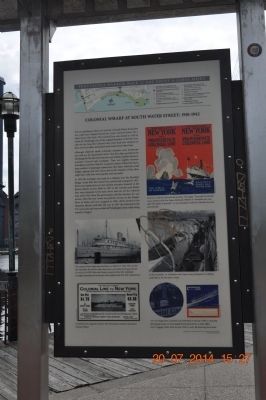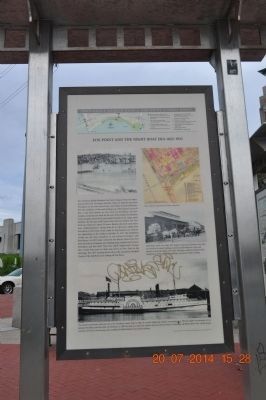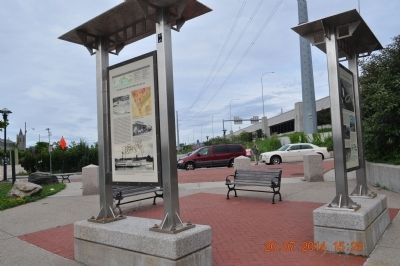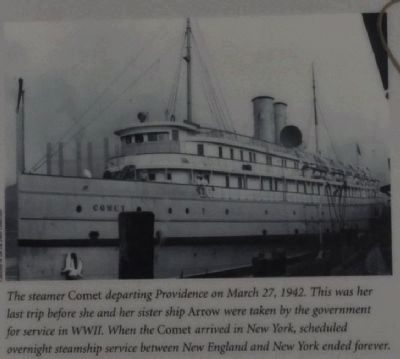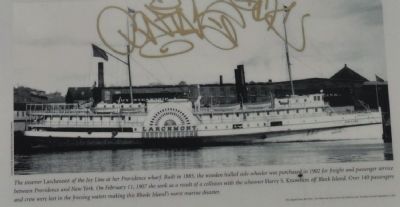Fox Point in Providence in Providence County, Rhode Island — The American Northeast (New England)
Colonial Wharf at South Water Street: 1910-1942 / Fox Point and the Night Boat Era 1822-1932
Inscription.
Providence Harbor walk at Fox Point & India Point
1. Fox Point and Night Boat Era 1822-1932 Firefly challenges the Stagecoach Era
2. Colonial Wharf at South Water Street: 1910-1942
3. Fox Point Hurricanes Barrier 1961-1966 Construction and 2005-2007 changes from I-I95 relocation
4. Providence River Bride Its design, construction and journey up Narragansett Bay by tugboat
5. Shipping Expands around the Point
6. Fox Point: the 19th Century Port of Providence Downgrades from goods and passengers to coal and scrap metals
7. Welcome to India Point Park
8. Welcome to Fox Point
9. Tockwooten and the Indiamen Ship building and trade with Orient India Point
10. Sails to Rails 1835: Providence’s First Train Station
11. Bridging the Seekonk
12. Rogers Williams Landing 1636
Colonial Wharf at South Water Street: 1910-1942 (side 1)
You are standing on what was once the Colonial Wharf. From here you could have stepped aboard the Comet (pictured below) for a night trip to New York. The Colonial Line was started in 1910 by Frank M. Dunbaugh, one of the original founders of the Joy Line. Like the Joy Line, the Colonial Line never built new steamers of their own but rather purchased used vessels from other lines.
Although relative small, Colonial’s steamers were handsome and well run by experienced crews. The first ships purchased by Dunbaugh for the new line were two iron-hulled propeller steamers, renamed Concord and Lexington.
They ran nightly between Providence and New York for a quarter-century. While they had a large number of passenger staterooms, they had a relatively small freight capacity and were not as fast as the steamers of the other nightlines. Still, they were popular and successful.
In 1935 the Lexington was sunk in a collision near the Brooklyn Bridge. A year later the Concord was retired and scrapped in 1937.
Both were replaced by two fast turbine steamers formerly in the Boston-Maine service. Built in 1907 as the Camden and Belfast they were renamed Comet and Arrow and ran on the Colonial Line until 1942 when the government took the steamers for war service.
After the war Comet was sold for service on the Yangtze River in China and was scrapped in 1950. Arrow served in the Hawaiian Island until after the war. In 1947 she returned to the U.S. west coast and was wrecked off Washington State while being towed to Oregon. The Steamer Comet departing Providence on March 27, 1942. This was her last trip before she and her sister ship Arrow were taken by the government for service in WWII. When the Comet arrived in New York, scheduled overnight steamship service between New England
and New York ended forever.
Cover of a 1928-29 Colonial Line brochure. The Slogan “The public be pleased” was a counter to the New Haven Railroad’s William H. Vanderbilt who once said “the public be damned”-it was intended to make the Colonial Line seem more friendly.
In this November 14, 1939 photo, the Comet crew participates in a lifeboat drill while at the Providence wharf.
Left:
An image from a Colonial Line letterhead in the late 1930s or early 40s showing passengers on the gangplank being greeted by a ship’s officer. Right: Luggage sticker from the late 1930s or early 40s featuring the Comet.
A Colonial Line magazine ad from 1915 showing the steamer Concord at Colonial Wharf.
(Side 2)
Fox Point and the Night Boat Era 1822-1932 (side2) For centuries Rhode Islanders have been trying to find ever-faster ways to New York. The latest, Amtrak’s Acela, can make the trip from Providence in less than three hours. Just before the Revolutionary War the condition of the roads leading out of Providence was such that a trip from Boston to New York via Providence and New London, consumed one week. By the turn of the century the adoption of the turnpike system led to great improvements in the stagecoach facilities. By the year 1805 travel time between Boston and New York was reduced to about 50 hours. Besides this land
route there were “palatial packets” (sloops from 60 to 100 tons), sailing from Providence to New York, which made the trip between one week or two depending on the weather and tides. In 1817, the steamboat Firefly was the first steamboat to run between Newport and Providence. In 1822 boats owned by the Rhode Island and New York Steamboat Company were making semi-weekly trips between Providence and New York. They were called “Night Boats” because they would leave port at dusk and arrive in New York in the morning. In 1832 drawings above show the steamboat Bradford Durfee of the Fall River Line sailing off Fox Point.
1918 Sanborn map of the Fox Point waterfront.
South Water Street circa 1900-1905, Freight transported to and from New York was stored in the wharf building and later passed through to a river-side steamer or land-side wagons and trucks. Passengers would also board and disembark here. To the right of the building is the present Corliss Landing.
Topics. This historical marker is listed in these topic lists: Industry & Commerce • Waterways & Vessels. A significant historical month for this entry is March 1835.
Location. 41° 49.011′ N, 71° 24.074′ W. Marker is in Providence, Rhode Island, in Providence County. It is in Fox Point. Marker is on Gano Street. Marker is located In the India Point Park before you get to the Hot Club. Touch for map. Marker is in this post office area: Providence RI 02903, United States of America. Touch for directions.
Other nearby markers. At least 8 other markers are within walking distance of this marker. The Fox Point Hurricane Barrier / A Second Life for the Hurricane Barrier (here, next to this marker); Providence River Park (within shouting distance of this marker); Providence River Bridge (about 400 feet away, measured in a direct line); Fox Point Veterans Memorial (about 700 feet away); Fox Point Cape Verdean Community (approx. ¼ mile away); Early History and Archaeology of Central Wharf (approx. 0.3 miles away); Central Wharf Shipping, Whaling, and Other Industries (approx. 0.3 miles away); Fox Point: The 19th Century Port of Providence / Shipping Expands Around the Point (approx. 0.3 miles away). Touch for a list and map of all markers in Providence.
Credits. This page was last revised on May 8, 2023. It was originally submitted on August 4, 2014, by Sandra Hughes Tidwell of Killen, Alabama, USA. This page has been viewed 717 times since then and 42 times this year. Photos: 1, 2, 3, 4, 5. submitted on August 4, 2014, by Sandra Hughes Tidwell of Killen, Alabama, USA. • Bill Pfingsten was the editor who published this page.
